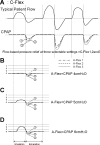Flexible positive airway pressure improves treatment adherence compared with auto-adjusting PAP
- PMID: 23372270
- PMCID: PMC3543062
- DOI: 10.5665/sleep.2378
Flexible positive airway pressure improves treatment adherence compared with auto-adjusting PAP
Abstract
Study objectives: There are no clinical data comparing adherence and quality of life between auto-adjusting positive airway pressure (APAP) and two different flex positive airway pressure (PAP) devices (A-Flex, C-Flex) in patients with obstructive sleep apnea (OSA).
Design and setting: Ninety-three patients in whom OSA was newly diagnosed were randomly assigned to receive 3 mo of APAP (n = 31), APAP with C-Flex (n = 31), or APAP with A-Flex (n = 31). Objective adherence was determined after 3 mo of CPAP treatment, and the Epworth Sleepiness Scale (ESS), Pittsburgh Sleep Quality Index (PSQI), and Calgary Sleep Apnea Quality of Life Index (SAQLI) were examined at baseline and after 3 mo. After 3 mo, patients in the APAP with A-Flex group and those in the APAP with C-Flex group were crossed over and those in the APAP group were switched to A-Flex for an additional 3 mo.
Measurements and results: The groups were similar demographically. Treatment adherence during the first 3 mo was significantly greater in the APAP with C-Flex group (APAP with C-Flex: 5.19 ± 1.84 h/night versus APAP: 3.96 ± 1.66 h/night versus APAP with A-Flex: 4.27 ± 2.12 h/night, P = 0.04). There was a significant improvement in two of four of the SAQLI domain scores and in the ESS and PSQI in the APAP with C-Flex group. Adherence significantly improved among the poor compliers (< 4 h/night of use) in the APAP group after change to APAP with A-Flex (P = 0.01).
Conclusions: Of these three modes of PAP delivery, adherence was greatest with APAP with C-Flex.
Clinical trial registration: URL: http://www.clinicaltrials.gov. Unique identifier: NCT00873977.
Figures




Similar articles
-
Positive airway pressure initiation: a randomized controlled trial to assess the impact of therapy mode and titration process on efficacy, adherence, and outcomes.Sleep. 2011 Aug 1;34(8):1083-92. doi: 10.5665/SLEEP.1166. Sleep. 2011. PMID: 21804670 Free PMC article. Clinical Trial.
-
A randomized, placebo-controlled trial using a novel PAP delivery platform to treat patients with OSA and comorbid PTSD.Sleep Breath. 2020 Sep;24(3):1001-1009. doi: 10.1007/s11325-019-01936-x. Epub 2019 Nov 6. Sleep Breath. 2020. PMID: 31691105 Clinical Trial.
-
Auto-adjusting positive airway pressure treatment for sleep apnea diagnosed by home sleep testing.J Clin Sleep Med. 2014 Dec 15;10(12):1269-75. doi: 10.5664/jcsm.4272. J Clin Sleep Med. 2014. PMID: 25348244 Free PMC article. Clinical Trial.
-
Heated humidification did not improve compliance of positive airway pressure and subjective daytime sleepiness in obstructive sleep apnea syndrome: A meta-analysis.PLoS One. 2018 Dec 5;13(12):e0207994. doi: 10.1371/journal.pone.0207994. eCollection 2018. PLoS One. 2018. PMID: 30517168 Free PMC article.
-
The use of auto-titrating continuous positive airway pressure for treatment of adult obstructive sleep apnea. An American Academy of Sleep Medicine review.Sleep. 2002 Mar 15;25(2):148-73. Sleep. 2002. PMID: 11902425 Review.
Cited by
-
APAP, BPAP, CPAP, and New Modes of Positive Airway Pressure Therapy.Adv Exp Med Biol. 2022;1384:297-330. doi: 10.1007/978-3-031-06413-5_18. Adv Exp Med Biol. 2022. PMID: 36217092 Review.
-
Pressure-Relief Features of Fixed and Autotitrating Continuous Positive Airway Pressure May Impair Their Efficacy: Evaluation with a Respiratory Bench Model.J Clin Sleep Med. 2016 Mar;12(3):385-92. doi: 10.5664/jcsm.5590. J Clin Sleep Med. 2016. PMID: 26564383 Free PMC article.
-
Poor versus good sleepers in patients under treatment for sleep-related breathing disorders: better is not good enough.Neuropsychiatr Dis Treat. 2014;10:131-3. doi: 10.2147/NDT.S58970. Epub 2014 Jan 17. Neuropsychiatr Dis Treat. 2014. PMID: 24465130 Free PMC article. No abstract available.
-
Effects of Pressure Control Device (SensAwake™) on Obstructive Sleep Apnea (OSA) Patients Who Remove the Mask for Unknown Reasons during Automatic Continuous Positive Airway Pressure (Auto-CPAP) Therapy: A Prospective Randomized Crossover Trial.Medicina (Kaunas). 2021 Aug 31;57(9):915. doi: 10.3390/medicina57090915. Medicina (Kaunas). 2021. PMID: 34577838 Free PMC article. Clinical Trial.
-
PAP Adherence and Nasal Resistance. A Randomized Controlled Trial of CPAPflex versus CPAP in World Trade Center Responders.Ann Am Thorac Soc. 2021 Apr;18(4):668-677. doi: 10.1513/AnnalsATS.202009-1161OC. Ann Am Thorac Soc. 2021. PMID: 33202147 Free PMC article. Clinical Trial.
References
-
- Marin JM, Carrizo SJ, Vicente E, Agusti AG. Long-term cardiovascular outcomes in men with obstructive sleep apnoea-hypopnoea with or without treatment with continuous positive airway pressure: an observational study. Lancet. 2005;365:1046–53. - PubMed
-
- Jenkinson C, Davies RJ, Mullins R, Stradling JR. Comparison of therapeutic and subtherapeutic nasal continuous positive airway pressure for obstructive sleep apnoea: a randomised prospective parallel trial. Lancet. 1999;353:2100–5. - PubMed
-
- Montserrat JM, Ferrer M, Hernandez L, et al. Effectiveness of CPAP treatment in daytime function in sleep apnea syndrome: a randomized controlled study with an optimized placebo. Am J Respir Crit Care Med. 2001;164:608–13. - PubMed
-
- Ayas NT, Patel SR, Malhotra A, et al. Auto-titrating versus standard continuous positive airway pressure for the treatment of obstructive sleep apnea: results of a meta-analysis. Sleep. 2004;27:249–53. - PubMed
-
- Nolan GM, Doherty LS, Mc Nicholas WT. Auto-adjusting versus fixed positive pressure therapy in mild to moderate obstructive sleep apnoea. Sleep. 2007;30:189–94. - PubMed
Publication types
MeSH terms
Associated data
LinkOut - more resources
Full Text Sources
Other Literature Sources
Medical
Research Materials

